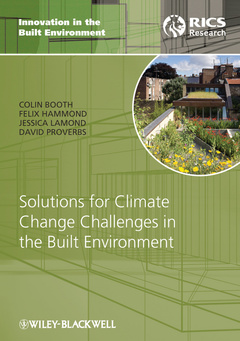Description
Solutions for climate change challenges of the built environment (series: innovation in the built environment) (hardback)
Innovation in the Built Environment Series, Vol. 5
Authors: Booth Colin A., Hammond Felix N., Lamond Jessica, Proverbs David G.
Language: English
Subject for Solutions for climate change challenges of the built...:
Approximative price 110.92 €
In Print (Delivery period: 12 days).
Add to cart256 p. · 17.8x27.2 cm · Hardback
Description
/li>Contents
/li>Biography
/li>
The book will form a collated volume of edited chapters following six related themes, provided by eminent specialists from both academic and professional backgrounds. The main context for the contributions will be the developed world but the discussion will be widened to incorporate regional issues.
The first part of the book sets the social, economic, political and natural science contexts within which the current debate on climate change is driven from a built environment perspective. The main purpose is to define the scope, principal themes, contradictions, consensuses and trends in the current climate change debate and place these in a built environment context. This will set the scene as well as the boundaries for the remaining discussions.
Part 2 concentrates on the negative outputs of the built environment, how these contribute to climate change and how these can be empirically captured. It covers the valuation of urban and natural environments in a broad sense and the role of measurement and valuation in policy formulation. This section also provides specific examples of impact measurement studies to illustrate the complexity of such evaluations.
Then follows an examination of the connection between the range of activities that precede development within the built environment and link these to the phenomena of climate change. This part looks at the consequences of socio-economic phenomena such as urbanisation and land preparation for development. It also examines the consequences of modern methods of land use planning, preparation and built environment design.
Having dealt with pre-development issues, Part 4 investigates the unique contributions that built environment development activities and land uses in particular make to climate change. This part looks at the influence that existing technology in the development of materials of construction continue to exert on growing climate change problems. It reports current and ongoing research findings on climate friendlier and more sustainable materials for construction. It also explores the climate change consequences of current methods and processes of construction and property development. Building and civil engineering design issues and their consequences will also form a major theme in this part, so too will be the environmental and economic issues surrounding green buildings.
Part 5 is concerned with existing methodologies of managing and maintaining built facilities. This part explores ways in which scientific methods of managing energy and other utilities in built facilities can be integrated into traditional methods of facilities management to reduce potential adverse consequences of existing facilities on climate change.
The concluding part of the book examines the principal methods and proposals for dealing and coping with the impacts of climate change in the built environment. It also focuses on the lessons that can be drawn from the discussions to inform future policy and strategic decision-making. Part 6 also examines the peculiar implications that the current state of climate change would have for the different regions of the world.
CONTENTS.
Part 1- the Climate Change Experience.
1. Introduction.
2. Climate Change: Nature and Emerging Trends.
3. The Green Economics Dialogue.
4. Global Political Initiatives and Overtones.
Part 2 - Valuation and Measurement of Impacts.
5. Strategic Environmental Impacts Assessment.
6. Valuing Environmental and Natural Resources: Theoretical Discussions.
7. Ecological Value of Urban Environments.
8. Pedological Value of Urban Landscapes.
9. Economics of Green Buildings.
Part 3 - Planning and Development Issues.
10. Urbanism, Urban Real Estate Economics and Climate Change.
11. Rural Drivers of Climate Change.
12. Recycling Brownfield Sites and Contaminated Lands.
Part 4 - Design and Construction.
13. Emerging Trends in Sustainable Construction.
14. Climate Receptive Design of Built Facilities.
15. Progress in Eco- and Resilient- Construction Material Development.
16. Sustainable Urban Drainage Systems.
17. Sustainable Transportation.
18. Organisational Culture and Climate Change Driven Construction.
Part 5 - Management of Developed Facilities.
19. Energy efficiency and emissions.
20. Modern Techniques in Conservation and Preservation of Buildings.
21. Waste Management.
Part 6 - The Future: Dealing and Coping with Climate Change.
22. Preparing for Extreme Weather Events.
23. Mitigation Measures.
24. Adaptation Measures.
25. Regional Implications.
26. Lessons for the Future.
.
.
MARKET DESCRIPTION.
Researchers and post graduate students in all the built environment disciplines
Felix N. Hammond, Lecturer, Construction and Infrastructure, School of Engineering and the Built Environment, University of Wolverhampton
Jessica Lamond, Post Doctoral Research Fellow, Construction and Infrastructure, School of Engineering and the Built Environment, University of Wolverhampton
David G. Proverbs, Professor and Head of Department, Construction and Property, Faculty of Environment and Technology, University of the West of England




